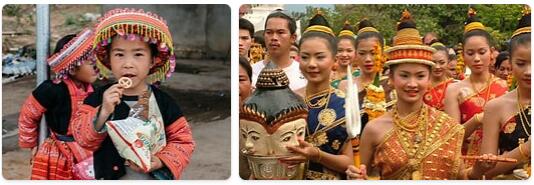In February 1993, the Supreme People’s Assembly met and appointed Nuhak Fumsavanh as Republican President and PPRL leader, Khamtay Sifandon as Prime Minister.
The country maintained its closed political system while capitalist-oriented economic reforms continued. In 1993, three former ministers remained in prison. In 1990, they had proposed the implementation of democratic reforms. In return, Prince Suvana Fuma was allowed to enter the country as a representative of foreign companies.
By the 1980s, annual inflation had reached 46%. Under IMF supervision it was now reduced to 10%. Gross domestic product increased 7%.
US state aid agency AID granted a $ 9.7 million loan to improve infrastructure in various parts of the country, arguing that improved access to markets would improve living conditions.

According to thesciencetutor, forestry has become a major problem in the country. By 1964, 6,000 m 3 had been felled. By 1993, the figure had risen to 600,000 m 3. The same year, the government imposed export restrictions. Instead, illegal forestry, which in 1993 accounted for about half of total forestry, increased. In March 1994, the World Bank initially granted Laos $ 8.7 million to plant new forests.
Several international environmental organizations sharply criticized the project, which relied on direct funding from the central government, without contact with the local authorities, who thus had no security to participate in the project. The organizations also criticized the great emphasis placed on planting trees for commercial exploitation. A development that would further jeopardize the forests and their inhabitants.
On April 6, 1994, the “Friendship Bridge” was opened across the Mekong River between Thailand and Laos. The project was an expression of reconciliation between the two countries, and that Laos withdrew from Vietnam and approached closer economic and cultural cooperation with Thailand, which was a richer country.
In a short time, Thai banks, media, transport companies and factories came to dominate the economic investment in Laos, which was increasingly deprived of its socialist principles. In March, a law was passed that removed the remnants of planning economics. Another law guaranteed professional rights and updated the regulation of professional activity. Yet the government was determined to preserve its communist identity.
In mid-1995, Laos expressed its desire to become a full member of the Southeast Asian Cooperation Organization (ASEAN) within a two-year period. The opening to foreign countries was also reflected in the ratification of a border agreement with Myanmar. At the same time, the United States lifted its blockade of the country that had continued since the end of the Vietnam War and which had limited the financial assistance of the superpower.
In March 1996, Prime Minister Siphandon reaffirmed the PPRL’s status as the country’s only legal party at its 6th congress, while emphasizing liberalization, efficiency and economic growth.
At the December 1997 parliamentary elections, PPRL maintained its dominance as 99 MPs were elected. The election results were not surprising, as only 4 of the 159 candidates stood outside the unit party.
The stock market crisis affecting several of the countries in the region also had downsides in Laos, although the scale was smaller than in Thailand and Malaysia. The main impacts were price increases on imported goods and basic consumer goods such as food.
In February 1998, the Supreme People’s Congress elected Prime Minister Siphandon as new president. Instead, Sisavat Keobounphan was appointed new prime minister. Deputy President Oudom Khattigna died at the age of 69 in December 1999. Amnesty International put pressure on the country to release its prisoners of conscience. One of these – Thongsouk Saysangkhi – died in prison despite a request for release from Amnesty.
